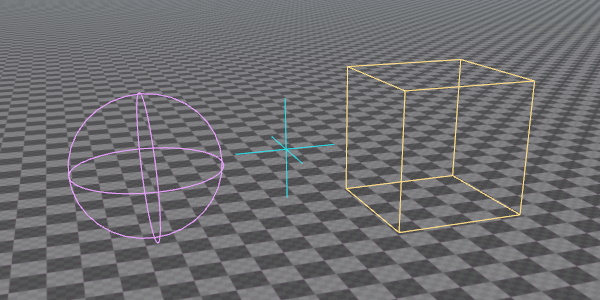Debug Rendering
The rendering in Plasma is optimized to handle large and complex data efficiently. However, to achieve this you must implement certain patterns, and to get started a non-trivial amount of code is involved. To visualize simple things, the plDebugRenderer is provided. This class allows you to quickly add debug visualizations to your game, with just a few lines of code.
This interface is also (partially) available through TypeScript.

Usage
The plDebugRenderer class has a number of static functions that you can call from any thread and at any time. The debug renderer gathers all requests and renders them at a specific point in the frame. Afterwards all requests are cleared and you must resubmit the same calls in the next frame, if you want it to appear again.
Render Context
Every function in plDebugRenderer takes an plDebugRendererContext as its first parameter. This specifies where the debug geometry should be rendered. You can either pass in an plViewHandle or an plWorld here. If you pass in a view handle, the geometry will only be rendered in the corresponding plView, meaning you can have the debug geometry only appear in a specific render target. If you pass in an plWorld, the geometry appears in all views that render that world.
It is more common to bind debug geometry to an entire plWorld, such that it appears in any view. The TypeScript binding omits the plDebugRendererContext parameter and always binds it to the world.
Debug Geometry Types
The debug renderer allows you to render arbitrary lines and triangles. For convenience it also provides functions to render a number of common shapes:
3D lines
2D lines (screenspace)
Boxes (wireframe)
Boxes (solid)
Spheres (wireframe)
Capsules (wireframe)
Frustums (wireframe)
3D triangles (solid)
3D triangles (textured)
2D rectangles (solid, screenspace)
2D rectangles (textured, screenspace)
2D text (screenspace)
2D info text (screenspace, automatically placed non-overlapping)
3D text (3D location, fixed size and always facing the camera)
Shading
The debug renderer always uses a fullbright shading model. No lighting is ever applied to debug geometry. In fact, most geometry simply has a color, and only some functions allow you to choose a texture.
Example
A full example for how to use the debug renderer is given in the Sample Game Plugin. Here, the DebugRenderComponent shows how to utilize the debug renderer.
The following code snippet is sufficient to render a wireframe sphere at the location of the component:
This has to be called in every frame in which it should appear. Therefore this has been added to the DebugRenderComponent::Update() function.
Performance Considerations
The debug renderer is meant for quickly visualizing data. If the data potentially changes every frame anyway (like visualizing AI raycasts), its performance will be on par with what a 'proper' solution could do. However, if you want to place things in a scene that may stay for a longer duration, it's usually much better to instead build a game object, attach a mesh component and just render a proper asset. This enables culling, static object optimizations, and gives you the option to choose materials.
See Also
Shader Debugging
Jolt Debug Visualizations
Custom Code with TypeScript